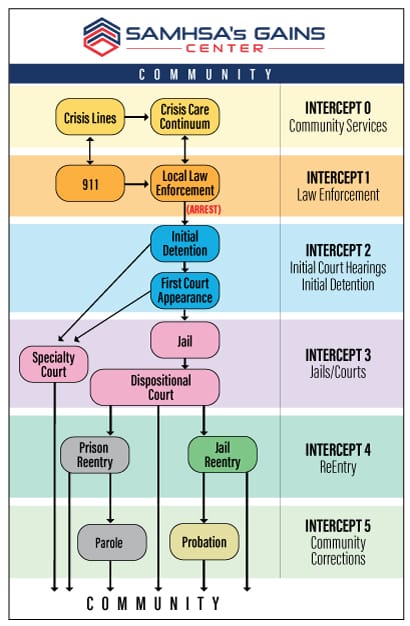Learning Agency project (BHA Course Build) completed for the University of Colorado Anschutz Medical Campus and the Behavioral Health Administration.
Client (who):
For the majority of the 2025 Spring semester, I worked for the Instructional Design Team within the Psychiatry Department at CU-Anschutz to create multiple eLearning modules for the Behavioral Health Administration (BHA). The project is ongoing, but the ultimate goal of the modules is to improve the quality of life of justice-involved people, and prevent future justice involvement.
Overview (what/when):
The BHA noticed that individuals who are justice-involved have a hard time while incarcerated, and after release as a result of multiple factors. It was determined that the Sequential Intercept Model (SIM) should be used to develop strategic action plans by assessing resources and identifying service gaps at each intercept point (The Sequential Intercept Model (SIM), n.d.). Refer to the image below for further explanation of SIM. As a designer, I was tasked with the analysis and design phases of ADDIE for a specialty course focused on law enforcement officers as the learners. This process involved the creation of a design document, working with SMEs, collaborating with fellow instructional designers, and creating an action map. The timeline to complete the analysis and design phase was mid-May.

Process:
To begin, I was given an ample amount of academic research to explore in order to determined the best learner group based on the established learning outcome for the course: Improve the quality of life for victims of crime and reduce the rate at which victims of crime are re-traumatized and/or re-victimized. After reviewing the research and collaborating with SMEs and other designers, the best learner group was determined to be law enforcement officers. Next, I was tasked with creating long-term, intermediate-term, and short-term outcomes for the course. These outcomes are outlined in an action map to show the through-lines/connections. Once this was approved, I began creating the course learning objectives to drive the design and development of the course. Finally, I was tasked with constructing the outline for the course by collaborating with a SME to add, review, and edit pertinent content.
The biggest challenges I encountered with this process were:
- Growing pains that come along with joining a pre-established team and project. I had to learn the process, procedures, and structures in order to function properly as a team member and successfully contribute.
- Surviving the analysis phase. It can be overwhelming to dive into academic research on a subject that you are not well-versed in. I had to “chunk” my research to avoid content overload and burnout.
Due to the sensitive nature of the course, completed documents are not available for public viewing. However, the brief overview document–attached below– displays two steps taken (action map and course learning objectives) within the design process to create a learning solution for law enforcement officers working with victims of crime. These two steps exemplify my ability to assess and address a problem in order to design an effective learning solution.
Outcome:
By mid-May, I had completed the analysis and design phases as requested and learned A TON. The learner group was identified, the action map and learning outcomes were created, and the design doc was complete. This story has a happy ending because it doesn't actually end quite yet! I think the lead designers have been satisfied with my work so far because I was asked to stay on the team post-graduation as a paid employee for the duration of the development phase. The course is expected to start development by the end of May and enter the peer review process by mid-to-late June.
Reflection:
The project went/is going well. I am incredibly happy that my contract was extended and I have the opportunity to continue learning. That said, I did learn a couple of lessons along the way:
- Be patient with yourself. I wanted to be great at everything right away, but it took time to adjust as I learned new things. Everyone has to start somewhere, so the more grace you give yourself to ask questions, make mistakes, and reflect, the better off your growth will be.
- I prefer design and development. I learned pretty early on in my work that reading through a bunch of research to determine outcomes, learner groups, etc. incited some serious insecurity for me. In other words, I felt unqualified to make decisions because I was not an expert in the field. Though I still feel this way, I learned that SMEs are there to help you in these situations. If you come to a conclusion about a learner group, but feel uncertain that your understanding is solid, you can ask your SME to review things and provide informed feedback.
Reference:
The Sequential Intercept Model (SIM). (n.d.). SAMHSA. https://www.samhsa.gov/communities/criminal-juvenile-justice/sequential-intercept-model







Member discussion